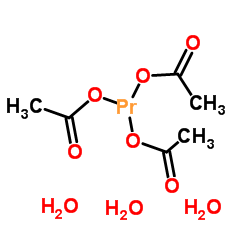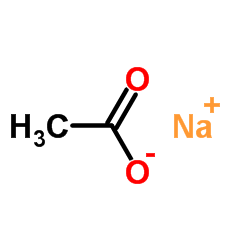praseodymium(3+) acetate
Modify Date: 2025-09-06 15:49:59

praseodymium(3+) acetate structure
|
Common Name | praseodymium(3+) acetate | ||
|---|---|---|---|---|
| CAS Number | 6192-12-7 | Molecular Weight | 372.086 | |
| Density | 1.2g/cm3 | Boiling Point | 536.2ºC at 760 mmHg | |
| Molecular Formula | C6H15O9Pr | Melting Point | N/A | |
| MSDS | N/A | Flash Point | 278.1ºC | |
| Name | praseodymium acetate |
|---|---|
| Synonym | More Synonyms |
| Density | 1.2g/cm3 |
|---|---|
| Boiling Point | 536.2ºC at 760 mmHg |
| Molecular Formula | C6H15O9Pr |
| Molecular Weight | 372.086 |
| Flash Point | 278.1ºC |
| Exact Mass | 371.979218 |
| PSA | 78.90000 |
| Index of Refraction | 1.618 |
| InChIKey | KPXRPRLCONABEG-UHFFFAOYSA-K |
| SMILES | CC(=O)[O-].CC(=O)[O-].CC(=O)[O-].[Pr+3] |
| Storage condition | 2~8℃ |
| Stability | hygroscopic |
|
Section 1: Product Identification Chemical Name:Praseodymium (III) acetate hydrate (99.9%-Pr) (REO) CAS Registry Number:6192-12-7 Formula:Pr(OOCCH3)3.XH2O EINECS Number:none Chemical Family:metal acetate salt Synonym:Acetic acid, praseodymium(+3) salt, hydrate
Section 2: Composition and Information on Ingredients IngredientCAS NumberPercentACGIH (TWA)OSHA (PEL) Title Compound6192-12-7100%no datano data Section 3: Hazards Identification Emergency Overview:Irritating to skin, eyes and respiratory tract. Primary Routes of Exposure:Ingestion Eye Contact:Causes slight to mild irritation of the eyes. Skin Contact:Causes slight to mild irritation of the skin. Inhalation:Irritating to the nose, mucous membranes and respiratory tract. Ingestion:No information on the physiological effects of ingestion. Acute Health Affects:Irritating to skin, eyes and respiratory tract. Chronic Health Affects:No information available on long-term chronic effects. NTP:No IARC:No OSHA:No SECTION 4: First Aid Measures Immediately flush the eyes with copious amounts of water for at least 10-15 minutes. A victim may need Eye Exposure: assistance in keeping their eye lids open. Get immediate medical attention. Wash the affected area with water. Remove contaminated clothes if necessary. Seek medical assistance if Skin Exposure: irritation persists. Remove the victim to fresh air. Closely monitor the victim for signs of respiratory problems, such as difficulty Inhalation: in breathing, coughing, wheezing, or pain. In such cases seek immediate medical assistance. Ingestion:Seek medical attention immediately. Keep the victim calm. Give the victim water (only if conscious). SECTION 5: Fire Fighting Measures Flash Point:not applicable Autoignition Temperature:none Explosion Limits:none Extinguishing Medium:carbon dioxide, dry powder or foam If involved in a fire, fire fighters should be equipped with a NIOSH approved positive pressure self-contained Special Fire Fighting Procedures: breathing apparatus and full protective clothing. Hazardous Combustion andIf involved in a fire this material may emit toxic organic fumes. Decomposion Products: Unusual Fire or Explosion Hazards: No unusual fire or explosion hazards. SECTION 6: Accidental Release Measures Spill and Leak Procedures:Small spills can be mixed with vermiculite or sodium carbonate and swept up. SECTION 7: Handling and Storage Store in a tightly sealed container in a dry place. If container is left open, salt may adsorb moisture from the Handling and Storage: atmosphere. SECTION 8: Exposure Controls and Personal Protection Eye Protection:Always wear approved safety glasses when handling a chemical substance in the laboratory. Skin Protection:Wear appropriate chemical resistant gloves and protective clothing. Ventilation:Material may form a fine dust. If possible, handle the material in an efficient fume hood. If in form of fine dust and ventilation is not available a respirator should be worn. The use of respirators Respirator: requires a Respirator Protection Program to be in compliance with 29 CFR 1910.134. Ventilation:Material may form a fine dust. If possible, handle the material in an efficient fume hood. Additional Protection:No additional protection required. SECTION 9: Physical and Chemical Properties Color and Form:green xtl. Molecular Weight:318.04 Melting Point:no data Boiling Point:no data Vapor Pressure:not applicable Specific Gravity:no data Odor:none Solubility in Water:very soluble SECTION 10: Stability and Reactivity Stability:hygroscopic solid Hazardous Polymerization:no hazardous polymerization Conditions to Avoid:contact with moisture Incompatibility:Oxidizing agents and active metals Decomposition Products:Carbon dioxide, carbon monoxide, organic vapors, and metal oxides and carbonates. SECTION 11: Toxicological Information RTECS Data:No information available in the RTECS files. Carcinogenic Effects:No data available Mutagenic Effects:No data available Tetratogenic Effects:No data available SECTION 12: Ecological Information Ecological Information:No information available SECTION 13: Disposal Considerations Disposal:Dispose of according to local, state and federal regulations. SECTION 14: Transportation Shipping Name (CFR):Non-hazardous Hazard Class (CFR):NA Additional Hazard Class (CFR):NA Packaging Group (CFR):NA UN ID Number (CFR):NA Shipping Name (IATA):Non-hazardous Hazard Class (IATA):NA Additional Hazard Class (IATA):NA Packaging Group (IATA):NA UN ID Number (IATA):NA SECTION 15: Regulatory Information TSCA:Listed in the TSCA inventory. SARA (Title 313):Title compound not listed. Second Ingredient:none SECTION 16 - ADDITIONAL INFORMATION N/A |
| Hazard Codes | Xi |
|---|---|
| Risk Phrases | R36/37/38 |
| Safety Phrases | S26-S36-S37-S39 |
|
~% 
praseodymium(3+... CAS#:6192-12-7 |
| Literature: Egypt. J. Chem., , vol. 26, p. 125 - 132 Sc: MVol.D4, 1.4.10, page 52 - 53 |
| Tris(acetato-κO)praseodymium trihydrate |
| Praseodymium, tris(acetato-κO)-, hydrate (1:3) |
| PRASEODYMIUM ACETATE |
| EINECS 228-242-4 |
| Praseodymium(III) acetate hydrate |
| MFCD00150121 |

